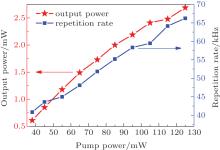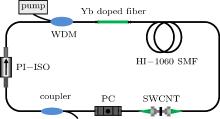†Corresponding author. E-mail: dispersion@126.com
Project supported by the National Key Scientific Instruments Development Program of China (Grant No. 2012YQ120047).
An all-fiber laser using a single-walled carbon nanotube (SWCNT) as the saturable absorber (SA) for Q-switched operation in the 1031 nm region is demonstrated in this work. A lasing threshold as low as 17 mW was realized for continuous wave operation. By further increasing the pump power, stable Q-switched pulse trains are obtained when the pump power ranges from 38 mW to 125 mW, corresponding to repetition rate varying from 40.84 kHz to 66.24 kHz, the pulse width from 2.0 μs to 1.0 μs and the highest single pulse energy of 40.6 nJ respectively.
Recently, highly stable and compact pulsed fiber lasers have been very appealing because of their stability, free maintenance, flexibility, and low cost.[1– 3] The Yb ion has a rather high absorption cross section, with wide absorption spectrum of 910– 980 nm and emission spectrum of 1040– 1100 nm, which permits the quantum efficiency as high as 90% and high doping concentration without the concentration quenching effect.[4– 6] Those characteristics mentioned above made the Yb-doped fiber laser become a research hot spot with the most rapid development. Q-switched fiber lasers are of great importance because they can be widely used in many fields, such as remote sensing, range finding, medicine, industry, and fiber communications.[7– 10]
Mostly, the methods for achieving Q-switched fiber laser operation include active modulation and passive modulation. Compared with active Q-switched fiber laser, [11] passive Q-switched fiber lasers are more compact in structure, convenient in operation, and stable in any environment.[12– 14] Typically, SAs are preferable to generate pulsed laser because of their compact size, and they can be displayed in many forms.[15] Due to their nature of polarization independence, both SESAMs and carbon nanotubes have potential to generate vector pulses.[16, 17] However, SESAMs require complex and costly clean room-based fabrication systems, [18] and are inconvenient to achieve all-fiber setup. SWCNTs have significant advantages over SESAMs because they can be easier fabricated, have faster recovery time, and wider operation range of the wavelength, which makes them ideal SAs for realizing all-fiber Q-switched lasers.[10, 18– 21]
Up to now, there have been many reported works on applications of SWCNT materials as SA to achieve mode locking.[10, 19– 24] However, there are only a few papers to obtain Q-switched pulse trains in the Yb-doped fiber lasers. Different from the parameters of fixed mode-locked fiber laser, [24– 26] the repetition rate of the Q-switched fiber laser is tunable by varying the pump power without pulse breaking. Unlike the repetition-rate-tunable mode-locked fiber laser with a distributed cavity length at different wavelengths, [27] the proposed Q-switched fiber laser offers a wider tunable range of repetition rate and exhibits a more flexible method for changing the repetition rate. In contrast to the mode-locked fiber laser based on SWCNTs generating picosecond and femtosecond pulses simultaneously, [28] the schematic layout of the Q-switched fiber laser is simpler, less expensive, and has higher single pulse energy.
In 2012, Yu et al. experimentally demonstrated a Q-switched Yb-doped double-cladding fiber laser based on SWCNTs, which was directly deposited on the core surface of the gain fiber, with a linear cavity and half space structure; a maximum output power of 1.3 W was obtained at the wavelength of 1070 nm, the pulse repetition rate was tuned from 9.1 kHz to 60 kHz with the shortest pulse width around 600 ns.[29] With an all-fiber ring cavity, Li et al. have proved that the SWCNT wall paper can act as a mode locker at a lower pump power and a Q-switcher at a higher pump power of 80 mW, the repetition rate increases from 30 kHz to 50 kHz and the pulse duration decreases from 2.7 μ s to 1.0 μ s with the increases of pump power, with the maximum output power of 988 μ W, corresponding pulse energy of 18.38 nJ.[21] Furthermore, Ahmad et al. performed a stable passive Q-switched YDFL operating at 1073 nm region by using SWCNT as SA, with the repetition rate ranging from 17.1 kHz to 23.6 kHz, pulse width from 3.11 μ s to 6.45 μ s, and maximum pulse energy of 4.4 nJ at the maximum pump power of 117.5 mW.[30]
In this work, a Q-switched YDFL in a simple all-fiber ring cavity is proposed and demonstrated, to the best of our knowledge, the highest single pulse energy of 40.6 nJ is obtained based on the SWCNT wall paper in the similar cavity of YDFL. The fabrication method of SWCNT wall paper is called electrical arc discharge technology, and the fabrication process is similar to the works in Refs. [19]– [21].
The experimental setup of the proposed Q-switched YDFL is shown in Fig. 1. The Q-switched fiber laser is based on an all-fiber ring laser cavity, which was core pumped with a laser diode emitting at 975.4 nm, whose maximal output power is 667 mW. The pump power was coupled into the cavity through a 980/1030 nm fused WDM. The gain material was a 20-cm-long single mode Yb-doped fiber, whose core absorption was 1200 dB/m at 976 nm with core and cladding diameter of 4.7 μ m and 125 μ m, respectively. The inline polarization controller was mounted on the single mode fiber HI-1060 to adjust the polarization state of circulating light. A polarization insensitive optical isolator was employed to ensure the unidirectional operation and to avoid any spurious reflected signals to go back to the active Yb-doped fiber. The SWCNT SA wall paper was inserted in the oscillator with the size of 1× 1 mm2 through sandwiching between the two FC/APC fiber connectors. The laser output was taken by a 10% coupler. All the passive components were combined by HI-1060 fiber, and the total cavity length was about 7 m. The fiber laser system is insensitive to vibration and general environment perturbation because of its all-fiber ring-cavity setup.
In the experiment, the Q-switched was self-starting when the pump power increases to 38 mW, which could be sustained over 125 mW pump power. It is noticed that a further increase of pump power will result in the damage of SWCNT. Figure 2 shows the optical spectrum of the laser, recorded at the maximal permitted pump power, the center operating wavelength was 1032 nm, which was tunable by slightly adjusting the PC, during which the Q-switched operation was still stable. In a certain polarization of stable Q-switched operation, the tuning of wavelength can also be achieved through changing the pump power, but the tuning range is less than 2 nm. As we all know, the Yb-doped fiber laser which operates at 1030– 1080 nm for a four-level system can be widely used in the engineering domain.[31]
 | Fig. 2. Output spectra of the proposed Q-switched YDFL at the pump power of 125 mW with the different polarization state. |
The output pulse trains are monitored by a photodetector/sampling oscilloscope (TEK DPO3050) combination after the 10% output port. The continuous wave occurred above the pump power of 17 mW, when the pump power was more than 38 mW, stable Q-switched pulse trains can be obtained without any adjustment of PC. When the pump power was 38 mW, the repetition rate was 40.84 kHz. As the pump power was increased to 125 mW, the repetition rate was elevated to 66.24 kHz. Figure 3(a) shows the typical pulse trains of the Q-switched laser with the pump power of 38 mW with a repetition rate of 40.84 kHz and a pulse width of 2.0 μ s. Figure 3(b) shows that with the pump power of 90 mW there is a repetition rate of 56.20 kHz and pulse width of 1.5 μ s. Figure 3(c) shows that with the pump power of 125 mW there is a repetition rate of 66.24 kHz and pulse width of 1.0 μ s.
The repetition rate and the output power can be varied by increasing the pump power; the relationship of the pump power with them was described in Fig. 4, which clearly shows that this experiment has a rather low threshold of 38 mW pump power for SWCNT to achieve stable Q-switched operation, and the corresponding output power of 0.61 mW, which increases to 2.69 mW at the maximum permitted pump power of 125 mW. The corresponding repetition rates are basically proportional to the pump power, with its value increasing from 40.84 kHz to 56.20 kHz.
 | Fig. 3. Stable pulse trains of the Q-switched lasers at (a) 38 mW, f = 40.84 kHz, τ = 2.0 μ s, (b) 90 mW, f = 56.20 kHz, τ = 1.5 μ s, and (c) 125 mW, f = 66.24 kHz, τ = 1.0 μ s. |
 | Fig. 4. The repetition rate and the output power versus the pump power in the Q-switched fiber laser. |
The response of the pulse width is inversely proportional to the pump power. As shown in Fig. 5, decreasing from an initial value of 2.0 μ s to 1.0 μ s with the pump power ranging from 38 mW to 125 mW, corresponding to single pulse energy of 14.9 nJ and 40.6 nJ, respectively. The low pump threshold and high pulse energy are mainly owing to a low saturation intensity of the SWCNTs, [32] compact construction, and strict operation of splicing fiber. In principle, we can reduce the pulse width further by shortening the ring laser cavity, because the pulse width was directly affected by the cavity length in a passively Q-switched fiber laser.[33, 34]
In summary, a compact passively Q-switched YDFL with a 7-m-long ring cavity has been demonstrated and the SA we used as Q switcher is single-walled carbon nanostructures, which has simple fabrication and rather low cost. The stable Q-switched pulse trains are obtained when the pump power is above 38 mW with the repetition rate ranging from 40.84 kHz to 66.24 kHz, pulse width from 2.0 μ s to 1.0 μ s, and pulse energy from 14.9 nJ to 40.6 nJ. The center wavelength we achieved is 1030 nm. To the best of our knowledge, we have achieved a rather low threshold pump power of 38 mW for Q-switched operation, corresponding to the highest single pulse energy (i.e., 40.6 nJ) for the all-fiber Q-switched Yb-doped fiber laser by a SWCNT wall paper. We believe that the higher pulse energy could be obtained by perfecting the performance of SWCNT, using double-clad gain fiber, or optimizing the output coupling ratio.[35, 36]
| 1 |
|
| 2 |
|
| 3 |
|
| 4 |
|
| 5 |
|
| 6 |
|
| 7 |
|
| 8 |
|
| 9 |
|
| 10 |
|
| 11 |
|
| 12 |
|
| 13 |
|
| 14 |
|
| 15 |
|
| 16 |
|
| 17 |
|
| 18 |
|
| 19 |
|
| 20 |
|
| 21 |
|
| 22 |
|
| 23 |
|
| 24 |
|
| 25 |
|
| 26 |
|
| 27 |
|
| 28 |
|
| 29 |
|
| 30 |
|
| 31 |
|
| 32 |
|
| 33 |
|
| 34 |
|
| 35 |
|
| 36 |
|




